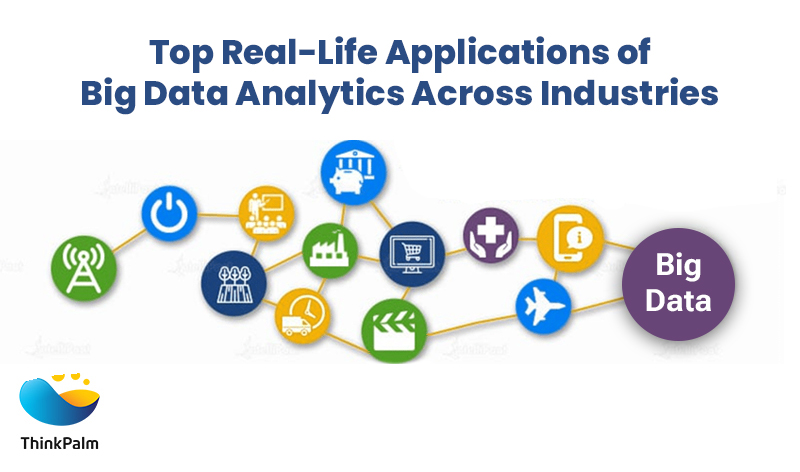In this digital world that we live in, the term ‘Big Data Analytics’ isn’t just a trend or buzzword—it’s a business’s heartbeat!
Every customer click, social media shout-out, and online purchase isn’t just data. Rather, it’s the pulse of business brilliance, decoded for strategic business success rather than simply stored.
So, how does it all work? Keep reading to explore how Big Data Analytics is shaking up the modern business scene.
We’ll also unpack this technology’s incredible benefits and highlight its significant real-world applications in 2024. Ready to take an insider view into the data-driven future? Let’s dive in!
Big data analytics is the muscle behind data-driven decision-making.
Essentially, it’s all about taming massive amounts of data—structured and unstructured—to uncover meaningful insights.
We’re talking terabytes, petabytes, and beyond, essentially, digital information mountains.
This field gets fancy with statistical techniques like clustering and regression, digging out patterns, correlations, and trends from the data.
Basically, it all started with technologies like Hadoop, Spark, and NoSQL databases, giving us the tools to handle this data tsunami.
Today, big data analytics and machine learning have become a powerful duo that enables us to foresee historical data and predict future trends and behaviors.
From sensor data to web patterns, big data analytics dives deep into the digital chaos. Moreover, it’s always changing as data engineers figure out how to blend diverse data sources and push the limits of what’s possible.
In a nutshell, big data analytics is the wizard turning raw data into actionable insights, guiding businesses toward savvy decision-making and a competitive edge in the data-driven age.
Big data analytics means gathering, sorting, cleaning, and studying massive amounts of data to help organizations use their data practically.
Organizations gather information from different places like cloud storage, mobile apps, and in-store sensors.
Then, this data is stored in organized warehouses or, if it’s a bit complicated, in a data lake with extra details.
Once we have the data, we organize it properly for accurate analysis. There are two ways to do this, as given below:
Batch Processing: Batch processing involves examining large datasets over time, making it beneficial for scenarios with a longer turnaround time.
Stream Processing: Checks out smaller data pieces quickly for faster decision-making. It’s a bit more complex and can cost more.
Data, regardless of its size, needs cleaning up for better quality.
Therefore, in this step, we should make sure it’s formatted correctly and filter any extra or repeated info to keep our insights on point.
Now that our data is ready, we use advanced tools to turn it into useful insights.
Methods include:
Data Mining: Finding patterns and connections.
Predictive Analytics: Using past data to guess what might happen in the future.
Deep Learning: Using smart tech to understand really complex data.
In simple words, big data analytics is like collecting, tidying up, and understanding data to help organizations make better decisions.
Big data analytics is a dynamic field with a diverse set of tools, each playing a crucial role in the data journey.
1. Hadoop: A tool that efficiently manages and processes big datasets. It’s free and can handle both structured and unstructured data.
2. NoSQL Databases: These are databases that don’t stick to a fixed structure. They’re good for handling raw and unorganized data.
3. MapReduce: A part of Hadoop that helps filter and organize data on different parts of a computer cluster.
4. YARN (Yet Another Resource Negotiator): Another part of Hadoop that helps manage how resources are used in the cluster.
5. Spark: A tool for computing on clusters of computers. It can quickly process both large batches of data and real-time streams.
6. Tableau: A platform that helps analyze and share big data insights in an easy-to-understand way.
These tools work together to make it easier for organizations to manage and make sense of big data.
What makes big data analytics a game changer? Big data analytics changes the game by quickly navigating massive amounts of data and ensuring efficient responses.
Moreover, its ability to handle diverse datasets allows for the rapid identification of opportunities and risks, ultimately improving agility and overall performance.
Some key benefits include:
✔Enhanced decision-making through data-driven insights.
✔Improved operational efficiency and cost optimization.
✔Targeted marketing and personalized customer experiences.
✔Proactive risk management and fraud detection.
✔Streamlined processes and agile business strategies.
✔Competitive advantage through predictive analytics.
✔Real-time monitoring for quick problem resolution.
✔Optimized supply chain management and inventory control.
✔Enhanced customer satisfaction and loyalty.
✔Innovating product development based on market trends.
Here are some top real-life applications of big data analytics across different industries:
What are the top trends in data and in 2024?
In 2024, top trends in data and analytics include the widespread adoption of artificial intelligence and machine learning applications, with a particular focus on natural language processing (NLP) and automated machine learning (AutoML).
What are the trends in big data analytics for 2025?
In 2025, expect big changes with AI, AI development services, and augmented analytics leading the way in reshaping data analytics.
How can big data transform your business?
Big data analytics has the power to transform your business by unlocking valuable insights, optimizing processes, and fostering data-driven decision-making. Also. it enables you to uncover patterns, trends, and opportunities in large datasets, leading to enhanced operational efficiency and a competitive edge.
Step confidently into the data-driven era with ThinkPalm’s Data Processing Services.
Our AI and Data Science-powered Big Data ecosystem ensures real-time insights across Healthcare, Consumer Electronics, IoT, Telecom industries, and more. So, you can leverage our expertise to unlock business opportunities, preserve critical data, and transform your approach.
In a world where over 97% of organizations ramp up their big data initiatives, the question is: Is your organization prepared to make intelligent decisions with precise data insights and guide your project to success? Don’t wait. Reach out to our big data analytics experts today!